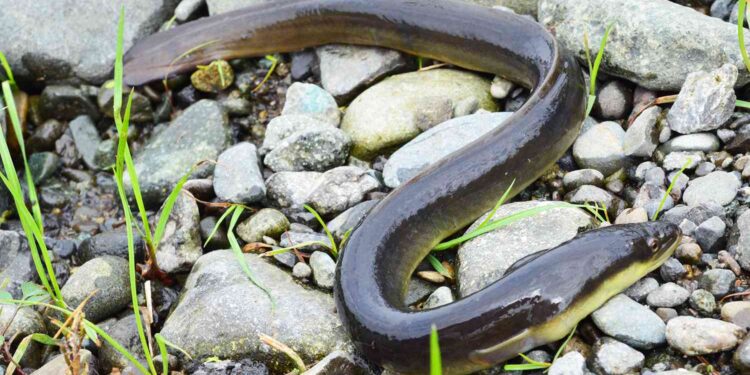:max_bytes(150000):strip_icc():format(jpeg)/japanese-eel-091624-1-211a6c8f902b43c09a68a0d91352d917.jpg)
Eels are evading becoming supper by slipping out of hungry predators.
A study published on Monday, Sept. 9, in the journal Current Biology has found that, while the Japanese eel (or Anguilla japonica) might be prey to dark sleeper fish (Odontobutis obscura), the circle of life doesn’t have to end there for the snake-like creatures thanks to a unique escape plan.
According to the study titled “How Japanese eels escape from the stomach of a predatory fish,” researchers used a few eels, x-ray footage, and a predator fish to determine the impressive way eels avoid getting eaten. Researchers found that the eels wiggle out of their predator’s stomach and escape through their gills after circling the stomach, along the eels to narrowly avoid becoming somebody’s lunch even when their “entire bodies were completely inside the stomach.”
“We thought the eel escaped from the mouth of the predator, but in the first footage we recorded, the eel escaped from the stomach of the predator,” Yuha Hasegawa, assistant professor at Nagasaki University and the initial author of the research, said, per The Japan Times. “It moved back up the digestive tract towards the gill of the fish.”
Antonio Duarte/Getty
Speaking with CNN, Hasegawa said while he and study coauthors Dr. Kazuki Yokouchi and Dr. Yuuki Kawabata previously saw the eels escape from the gills of dark sleepers thanks to a previous study in 2021, they had “no understanding of their escape routes and behavioral patterns during the escape because it occurred inside the predator’s body.”
To learn more about the eels’ journey to the gills, the researchers injected the fish with barium sulfate, which allowed them to use an X-ray video to see what was occurring inside the predator fish. Hasegawa told CNN that the research began with 104 eels, which were then — one at a time — placed inside “experimental tanks” with predator fish.
Of the 32 eels swallowed whole by the predator fish, 13 reached the fish’s gills and poked their tails out, while nine of the 13 “completed their escape,” per the study.
The study added that the eels typically escaped with an “initial tail-insertion towards the esophagus,” swimming backward, poking their tail through the gills, and eventually pulling their heads — and the rest of their body — free. The process took an average of three-and-a-half minutes.
Never miss a story — sign up for PEOPLE’s free daily newsletter to stay up-to-date on the best of what PEOPLE has to offer, from celebrity news to compelling human interest stories.
Kory Evans, an assistant professor of biosciences at Rice University in Houston, told CNN that the findings were “super surprising and informative.”
“The X-ray video of the eels circling in the stomach looking for a way out is particularly striking and shows that for some prey animals, the fight for survival doesn’t end after being eaten — kind of inspiring, really,” Evans said.
Hasegawa told The Guardian that the predatory fish were unharmed in the study, and the eels that escaped to freedom sometimes “showed signs of abrasions.”
“At this point, the Japanese eel is the only species of fish confirmed to be able to escape from the digestive tract of the predatory fish after being captured,” author Yuuki Kawabata said, per the outlet.
The study’s authors added that more research needs to be done—including on different-size eels and environments—to determine “specific factors that enable successful escape,” per CNN.







